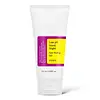What's inside
What's inside
 Key Ingredients
Key Ingredients

 Benefits
Benefits

 Concerns
Concerns

 Ingredients Side-by-side
Ingredients Side-by-side

Water
Skin ConditioningAcrylates Copolymer
Steareth-2
EmulsifyingSorbitol
HumectantCocamide
EmulsifyingPapain
Skin ConditioningCalcium Pantothenate
Xanthan Gum
EmulsifyingUrea
BufferingCaprylyl Glycol
EmollientMagnesium Lactate
BufferingEthylhexylglycerin
Skin ConditioningPotassium Lactate
BufferingSerine
MaskingAlanine
MaskingProline
Skin ConditioningMagnesium Chloride
Steareth-21
CleansingGlyceryl Stearate
EmollientTriethanolamine
BufferingCetyl Alcohol
EmollientLactobionic Acid
BufferingPhenoxyethanol
PreservativeBenzyl Alcohol
PerfumingPvp
Emulsion StabilisingPotassium Sorbate
PreservativeDisodium EDTA
Niacinamide
SmoothingAspalathus Linearis Extract
Skin ConditioningTocopherol
AntioxidantWater, Acrylates Copolymer, Steareth-2, Sorbitol, Cocamide, Papain, Calcium Pantothenate, Xanthan Gum, Urea, Caprylyl Glycol, Magnesium Lactate, Ethylhexylglycerin, Potassium Lactate, Serine, Alanine, Proline, Magnesium Chloride, Steareth-21, Glyceryl Stearate, Triethanolamine, Cetyl Alcohol, Lactobionic Acid, Phenoxyethanol, Benzyl Alcohol, Pvp, Potassium Sorbate, Disodium EDTA, Niacinamide, Aspalathus Linearis Extract, Tocopherol
Water
Skin ConditioningBambusa Arundinacea Stem Powder
AbrasiveCellulose
AbsorbentGlycerin
HumectantRosa Damascena Flower Water
MaskingPropanediol
SolventButylene Glycol
Humectant1,2-Hexanediol
Skin ConditioningAcrylates/C10-30 Alkyl Acrylate Crosspolymer
Emulsion StabilisingHydroxyacetophenone
AntioxidantLavandula Angustifolia Flower Water
Skin ConditioningTromethamine
BufferingNiacinamide
SmoothingMaltodextrin
AbsorbentEthylhexylglycerin
Skin ConditioningDisodium EDTA
Pentylene Glycol
Skin ConditioningLactobionic Acid
BufferingPapain
Skin ConditioningHyaluronic Acid
HumectantHydrolyzed Hyaluronic Acid
HumectantLactobacillus/Soybean Ferment Extract
Skin ConditioningSodium Hyaluronate
HumectantSodium Metabisulfite
AntioxidantLactobacillus/Rice Ferment
Skin ConditioningCamellia Japonica Flower Extract
EmollientWater, Bambusa Arundinacea Stem Powder, Cellulose, Glycerin, Rosa Damascena Flower Water, Propanediol, Butylene Glycol, 1,2-Hexanediol, Acrylates/C10-30 Alkyl Acrylate Crosspolymer, Hydroxyacetophenone, Lavandula Angustifolia Flower Water, Tromethamine, Niacinamide, Maltodextrin, Ethylhexylglycerin, Disodium EDTA, Pentylene Glycol, Lactobionic Acid, Papain, Hyaluronic Acid, Hydrolyzed Hyaluronic Acid, Lactobacillus/Soybean Ferment Extract, Sodium Hyaluronate, Sodium Metabisulfite, Lactobacillus/Rice Ferment, Camellia Japonica Flower Extract
 Reviews
Reviews

Ingredients Explained
These ingredients are found in both products.
Ingredients higher up in an ingredient list are typically present in a larger amount.
Disodium EDTA plays a role in making products more stable by aiding other preservatives.
It is a chelating agent, meaning it neutralizes metal ions that may be found in a product.
Disodium EDTA is a salt of edetic acid and is found to be safe in cosmetic ingredients.
Learn more about Disodium EDTAEthylhexylglycerin (we can't pronounce this either) is commonly used as a preservative and skin softener. It is derived from glyceryl.
You might see Ethylhexylglycerin often paired with other preservatives such as phenoxyethanol. Ethylhexylglycerin has been found to increase the effectiveness of these other preservatives.
Lactobionic Acid is a PHA. PHAs are the gentle cousins to AHAS.
Like AHAs, they exfoliate the top layer of skin. Lactobionic acid also exhibits significant antioxidant activity.
PHAs are more gentle than AHAs due to their larger structure. This means they do not penetrate as deeply as AHAs and take a longer time to dissolve dead cells. Studies show PHAs do not cause as much irritation.
By removing dead skin cells, PHAs leave the skin brighter and with even-texture.
Learn more about Lactobionic AcidNiacinamide is a multitasking form of vitamin B3 that strengthens the skin barrier, reduces pores and dark spots, regulates oil, and improves signs of aging.
And the best part? It's gentle and well-tolerated by most skin types, including sensitive and reactive skin.
You might have heard of "niacin flush", or the reddening of skin that causes itchiness. Niacinamide has not been found to cause this.
In very rare cases, some individuals may not be able to tolerate niacinamide at all or experience an allergic reaction to it.
If you are experiencing flaking, irritation, and dryness with this ingredient, be sure to double check all your products as this ingredient can be found in all categories of skincare.
When incorporating niacinamide into your routine, look out for concentration amounts. Typically, 5% niacinamide provides benefits such as fading dark spots. However, if you have sensitive skin, it is better to begin with a smaller concentration.
When you apply niacinamide to your skin, your body converts it into nicotinamide adenine dinucleotide (NAD). NAD is an essential coenzyme that is already found in your cells as "fuel" and powers countless biological processes.
In your skin, NAD helps repair cell damage, produce new healthy cells, support collagen production, strengthen the skin barrier, and fight environmental stressors (like UV and pollution).
Our natural NAD levels start to decline with age, leading to slower skin repair, visible aging, and a weaker skin barrier. By providing your skin niacinamide, you're recharging your skin's NAD levels. This leads to stronger, healthier, and younger looking skin.
Another name for vitamin B3 is nicotinamide. This vitamin is water-soluble and our bodies don't store it. We obtain Vitamin B3 from either food or skincare. Meat, fish, wheat, yeast, and leafy greens contain vitamin B3.
The type of niacinamide used in skincare is synthetically created.
Learn more about NiacinamidePapain is an enzyme found naturally in the papaya plant's leaves, fruit, and roots. It has antimicrobial, soothing, and wound healing properties.
Glycine and Vitamin A are naturally found in papain.
While papain is often touted as skin-lightening, further studies are needed to prove this. However, papain has been shown to help soothe acne-inflammation.
Papain belongs to a class of enzymes called proteolytic enzymes. These enzymes break down peptides and amino acids.
Some studies found papain to be a potential skin sensitizer and allergen. Those with latex allergies might also be allergic to papaya.
Learn more about PapainWater. It's the most common cosmetic ingredient of all. You'll usually see it at the top of ingredient lists, meaning that it makes up the largest part of the product.
So why is it so popular? Water most often acts as a solvent - this means that it helps dissolve other ingredients into the formulation.
You'll also recognize water as that liquid we all need to stay alive. If you see this, drink a glass of water. Stay hydrated!
Learn more about Water